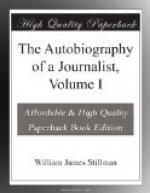I may frankly say as to Turner’s art, that I enjoyed most the water-colors of the middle period, though the latest gave me another kind of delight,—that of the reading of a fairy-story, of the building of glorious castles in the air in my younger days, that of something to desire and despair of. The drawings of the England and Wales series in the possession of Ruskin seemed to my critical faculty the ne plus ultra of water-color painting,—especially the “Llanthony Abbey,” of which I recall those early impressions with the greatest distinctness[1]. I saw in the Academy Exhibition the last pictures he ever exhibited, some whaling subjects, fresh from his retouching of two days before, gorgeous dreams of color art, but only dreams—the actuality had all gone out. I saw them years after when they had become mere wrecks, hardly recognizable.
[Footnote 1: I saw it again in the Guildhall Exhibition of 1899.]
I saw also that year a picture by Rossetti and one by Millais, and the latter impressed me very strongly; in fact it determined me in the manner in which I should follow art on my return home. I did not and could not put it on the same plane as the “Llanthony Abbey,” but the straight thrust for the truth was evidently the shortest way to a certain excellence, and this of the kind most akin to my own faculties, and I said to Delf, who was with me at the exhibition of the Academy, that if ever English figure painting rose out of mediocrity it would be through the work of the P.R.B. My impression is that the picture was the “Christ in the Carpenter’s Shop,” but of this I cannot be sure, though I am certain that it was in the exhibition of 1850. The Rossetti was in the old “National Society,” and was either the “Childhood of the Virgin Mary” or the “White Lady.” Beautiful as it was, it did not impress me as did the temper of Millais’s work, the scrupulous conscientiousness of which chimed with my Puritan education. I left England with a fermentation of art ideas in my brain, in which the influence of Turner and Pyne, the teachings of Wehnert, and the work of the Pre-Raphaelites mingled with the influence of Ruskin, and especially the preconception of art work derived from the descriptions, often strangely misleading, of the “Modern Painters.”
I received from my brother, as I had anticipated, the order for a passage on the Atlantic, one of the Collins line of steamers, and one of my fellow-passengers was Jenny Lind, on her way for her first visit to America under the guidance of Barnum. She gave a concert on board for the benefit of the firemen and sailors, and to this the half of Delf’s sovereign contributed, the other half going for a bottle of Rhine wine, to return the compliment of my next neighbor at the table, who had invited me to take a glass of wine one day. Thus, as usual, I landed penniless from my venture, but fortunately found my brother on the wharf expecting the arrival of the steamer, her trips having been made with such precision




